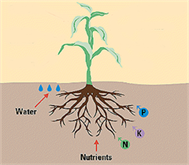2. The root does not only absorb ... and … … from the soil, it also anchors the plant.
3. The plant is divided into two parts – the root system and the … … portion.
4. Both roots and stems may serve as a ... organ.
5. Water and plant nutrients … by the stem from ... to … .
6. The smallest roots through which water is absorbed are known as … … .
7. Some crops have ... stems.
8. Small grains often ... due to unfavourable weather conditions.
9. Lodging can be controlled by growing ... varieties.
2. Determine which words from the right column can be combined with the word from the left column.
| root | long, crop, fibrous, size, water, main, previous, general, tap, small, hairs; stem |
| stem | adverse, hollow, short, solid, similar, mineral, pith, due, lodging |
| to obtain | weather, yield, seed, seedlings, flowers, nutrients, food products, rain, measure |
Put down your word combinations.
3. Translate the following sentences into English (in writing):
а)
1. Семена производятся семенными растениями.
2. Образовав семена, однолетние растения погибают.
3. Растение состоит из корней и надземной части.
4. Корни поглощают воду и питательные вещества из почвы.
5. Углеводы производятся в листьях.
6. Полегание обусловлено неблагоприятным воздействием погоды.
7. Некоторые растения не производят семян.

b)
1. Все растения, размножающиеся семенами, производят цветы.
2. Каждое растение состоит из двух основных частей, это корень и надземная часть. Первая обеспечивает растение водой и питательными веществами. Вторая, состоящая из листьев и стеблей, производит углеводы.
3. Все корнеплоды способны расти и производить семена на второй год благодаря питательным веществам, накопленным ими в первый вегетационный период.
4. Стебель не только проводит воду и питательные вещества от корня к листьям, но и поддерживает листья.
5. Стебли бывают двух видов: полые и выполненные.
6. Примером культуры, имеющей выполненный стебель, является кукуруза.
7. Некоторые сорта зерновых полегают, т.е. они не могут противостоять неблагоприятным погодным условиям.
Grammar and Vocabulary Activities
4. Give the Compound Participle forms of the following verbs and translate them.
to absorb, to increase, to produce, to store, to mention.
5. Match the dictionary definitions with the following words:
root, fibrous root, tap root, stem, fertilizer, green manure, plant nutrients.
1. Materials absorbed by plants and used by them for growth and development.
2. Any organic or inorganic material that is added to the soil to provide plant nutrients.
3. The kind of a root consisting of many roots of the same diameter and length.
4. The above ground portion of a plant that conducts water and plant nutrients from root to leaf.
5. The part of a plant that absorbs water and nutrients from the soil.
6. A crop grown for ploughing under when it is green.
7. The kind of root that consists of the main root and small branches throughout its length.
6. Answer the following questions to text A:
1. What is vegetative phase characterized by?
2. When does a plant complete its life cycle?
3. What are the functions of the roots?
4. What kinds of roots are there?
5. Why are leaves so important?
6. What functions does a stem perform?
7. What crops have hollow stems?
8. What is a very important quality of a cereal stem?
7. Read text B without using a dictionary and quess the meaning of the words in bold.








